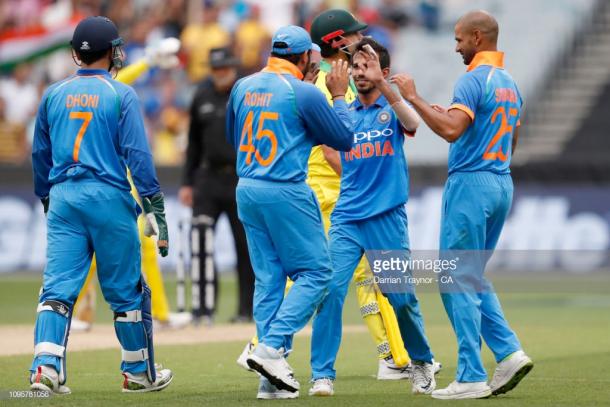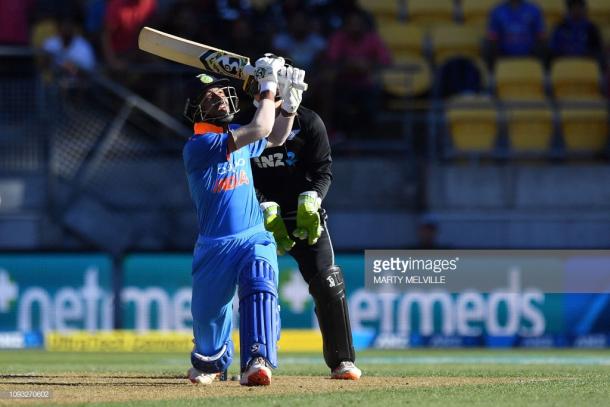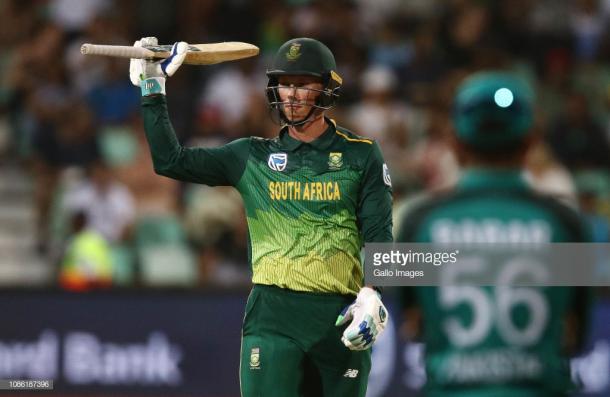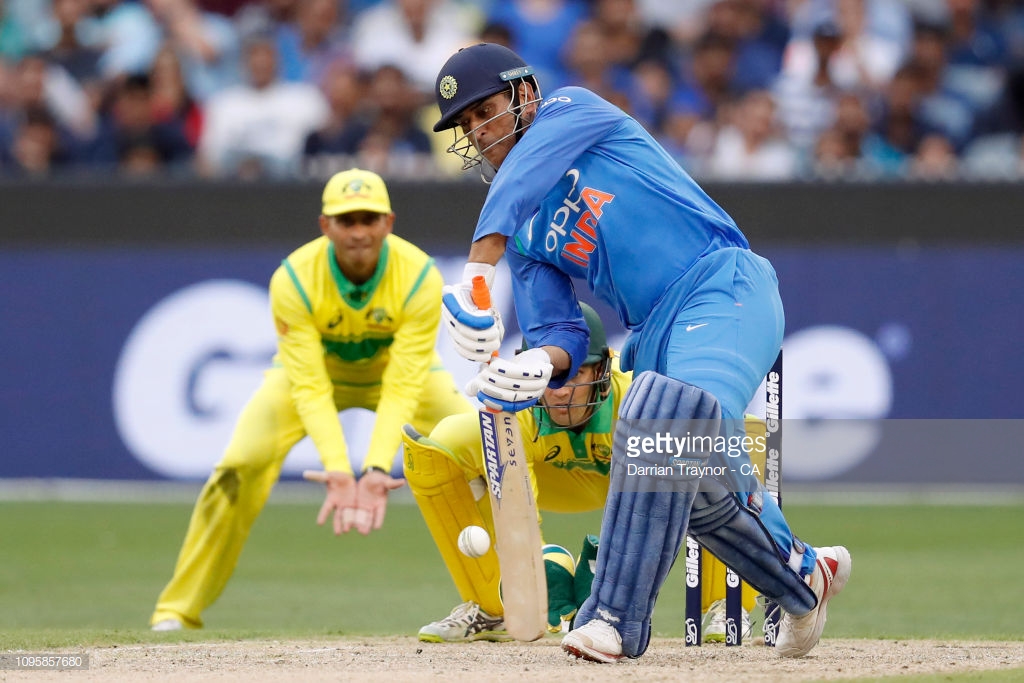January has seen an abundance of cricket around the globe, with plenty of ODI matches to look back on and gauge how certain teams are rounding into form ahead of the showpiece event which begins at the end of May.
Dhoni times his run to perfection during comeback win in Australia
Backing up their impressive Test series victory in Australia, there was no hangover for the Indian cricketers who have claimed back-to-back ODI series victories over the Aussies and then New Zealand.
Virat Kohli’s men are rounding into shape, and with most bases covered they will be very pleased with how things look at this stage in the World Cup process.
Having fallen behind in the three-match series in Australia, two masterful knocks from MS Dhoni in Adelaide (55*) and Melbourne (87*) helped his side claim a 2-1 victory, winning with four balls to spare in both of the final two matches.
Dhoni was the star of the show at the MCG, with the veteran sharing an unbeaten stand of 121 with Kedar Jadhav (61 not out) to chase down Australia’s tame total of 230. For now, he looks to have seen off the challenge of Rishabh Pant ahead of the World Cup, with the swashbuckling left-hander very likely to take over the keeper role once India’s tournament comes to an end.
Yuzvendra Chahal’s 6-42 were the main reason India had to chase such a low total in Melbourne. If Chahal and fellow wrist-spinner Kuldeep Yadav can continue to bamboozle opposition batting lineups then that will be a huge fillip for the 2011 world champions.

Shaun Marsh proved why he is such a vital cog in the Aussie batting lineup during the series with the elder brother hitting 14 boundaries on his way to 131 in the second match at the Adelaide Oval. Marsh is hitting peak form in the 50-over game, with his latest century giving him his fourth triple-figure score from his previous nine outings.
Another to impress for the hosts was young fast bowler Jhye Richardson. The young tyro has had a couple of strong Big Bash seasons with the Perth Scorchers, and has now proved that he can take that form into the international game.
A match-winning 4-26 in the opener saw him dominate at the start and end of India’s innings, and by the time the series was over he had claimed the scalp of kingpin Kohli on all three occasions. With Pat Cummins, Josh Hazlewood and Mitchell Starc all rested for the home one-dayers, Richardson was the man who bashed down the door loudest and is now in prime position to be awarded a World Cup berth at the expense of Billy Stanlake who struggled throughout.
Bowling unit shines as India outplay Kiwis during 4-1 series victory
On the second leg of their white-ball tour, India looked to be hitting prime form with the ball, as their attack spearheaded a 4-1 victory over New Zealand.
Mohammad Shami and Bhuvneshwar Kumar may be fighting it out a spot in the final XI once Jasprit Bumrah returns, and each of them enjoyed strong showings during this series. Shami’s nine wickets edged out Kumar who claimed seven, with his economy rate also slightly improved, ending his four outings by conceding less than five an over.
Chahal and Kuldeep shared 17 wickets, ripping out the heart of the Kiwi batting lineup on a couple of occasions, while the returning Hardik Pandya claimed four wickets from his 21 overs and really helped to balance out the lineup once you account for his power hitting (145 strike rate) and prowess in the field.

On the batting front, Ambati Rayudu rebounded from a tough spell in Australia to finish top of the run scoring charts at the end of this series. India’s number four scored 190 runs from his five innings at an average north of 60, and with Kohli resting for the back-end of this series his runs proved crucial.
The opening duo of Shikhar Dhawan and Rohit Sharma each had two half-centuries apiece in what was a tough series for batsmen on the whole, while India afforded themselves the opportunity to take a look at young prodigy Shubman Gill.
For the Kiwis, being dismissed for scores of 157, 217, 243 and 234 inside 50 overs during their four defeats has left huge questions just months out from the World Cup.
The over-reliance on Kane Williamson (162 runs at 32.40) and Ross Taylor (177 @ 44.25) has come to the fore, with the remainder of the batting lineup still yet to really nail down their spots in the order.
Martin Guptill is a certainty to open the batting, but his return of 47 runs from four innings in this series is a big concern. He was dismissed by Bhuvneshwar Kumar three times inside the powerplay and with fellow opener Colin Munro producing another underwhelming performance, there is no confidence in the top order.
The bowling attack revolves around one man. Trent Boult is a master of his craft, and without his 12 wickets in this series it could have been one of the most one-sided whitewashes in living memory.
The next highest wicket takers for the Kiwis were Matt Henry and Colin de Grandhomme, with their four and three wickets each coming in the space of one bowling innings. De Grandhomme in particular seemed like a one-off, with all of his scalps coming in the 4th ODI in Hamilton when the tourists were dismissed for 92 sans-Kohli on a seaming wicket.
Mitchell Santner produced some miserly spells, but only took one wicket, while the remainder of the attack all struggled to keep the run rate down. Tim Southee’s struggles echo those of Guptill with the bat, and although he is one of the first names on the teamsheet, his recent white ball struggles will add to the concern.
Kiwis stomp on Sri Lankans despite Perera magic
Guptill (138) and Henry Nicholls (124*) each struck centuries, and as did Ross Taylor who plundered 137 of his 281 runs in the series to wrap-up the whitewash in Nelson.
Taylor struck half centuries in each of the other matches, averaging 93.66 during the three matches, while there was a welcome return for Jimmy Neesham who plundered 10 sixes during the series, scoring 123 late over runs at a strike rate north of 200.
Neesham also did well on the bowling front (6 wickets from 20 overs), while Ish Sodhi and Lockie Ferguson each nailed down spots in the World Cup squad following strong showings with eight and six wickets apiece.
For Sri Lanka, strong individual efforts with the bat show promise, but they will be seen as an opponent most of the others will fancy their chances against in England this summer.
Thisara Perera has proved he is capable of the extraordinary, nearly pulling off one of the best single handed chases of all time during the second ODI at Mount Maunganui.
Requiring nearly 200 runs for victory when coming to the crease at 121-5, Perera smoked 13 sixes in his mammoth innings of 140 which came from just 74 deliveries. When he was finally the last man out, Sri Lanka fell just 21 runs short of a remarkable victory.
Kusal Perera, Niroshan Dickwella and Danushka Gunathilaka all enjoyed fruitful series with the bat too, but the team fell short while chasing on all three occasions by 45, 21 and 115 runs to suffer defeat in each match.
Lasith Malinga was their only real success story with the ball, and it looks like he will be leading the attack at another major tournament. His seven wickets were highly expensive (7.20 runs per over), but with Nuwan Pradeep’s three dismissals the next best for the tourists, they would have lost by even larger margins without him.
Proteas sneak past Pakistan in topsy-turvy five-match series
Having suffered heavy defeats in the red-ball leg of their South African tour, Pakistan showed signs of life during an intriguing ODI series which came down to the Newlands decider.
For the hosts, a fair amount of experimentation took place in their selection, with Dale Steyn, Quinton de Kock and Duanne Olivier all afforded periods of rest during the series.
One of the shining lights ended up being Rassie van der Dussen, with the stylish right-hander scoring three half-centuries from his four innings to end with an aggregate of 241 runs. The 29-year-old’s performances will have given the selectors a few headaches, with the likes of JP Duminy, Reeza Hendricks and Aiden Markram now potentially battling for a couple of positions in the 15-man World Cup squad.

The other big talking point throughout this series for the hosts has been the number seven slot, which they would for an all-rounder to go out and grab.
On this occasion, Andile Phehlukwayo was given the opportunity to impress, playing in all five matches. His big day out came in the second ODI at Kingsmead, when he starred with both bat and ball to stop his side suffering a second straight defeat.
After claiming extraordinary figures of 4-22 from his 9.5 overs to help bowl out the tourists for 203, Phehlukwayo followed it up with an unbeaten 69 to lead his side to a five-wicket victory. Coming to the crease at 80-5, the youngster hit seven boundaries and two maximums to share an unbeaten match-winning stand of 127 alongside van der Dussen (80*).
Having posted career-bests with both bat and ball in Durban, Phehlukwayo had an opportunity to nail down the main all-rounder spot in the line-up, but followed it up with just 11 runs and three wickets in the remaining matches.
For Pakistan, inconsistency continues to be the standard for them, and that was epitomised in games four and five where they followed up a thumping eight-wicket victory with a seven-wicket defeat in the decider.
Mickey Arthur’s side are probably more settled than their hosts, with the majority of their line-up in this tour likely to lead their charge in England later this year.
Imam-ul-Haq battled his way to a pair of half-centuries, and a terrific 101 in Centurion to top the run charts for both sides at an average of 54.20. His place at the top of the order alongside Fakhar Zaman should now be consolidated for the World Cup, with Babar Azam, Mohammad Hafeez and Shoaib Malik set to complete the middle-order despite only scoring three half-centuries between them in 13 innings.
Shaheen Shah Afridi’s continued stardom is a real boon for the bowling attack, with his six wickets helping the 18-year-old lead the way for the tourists on that front. Fellow left-armer Usman Shinwari produced a stunning spell to wreck South Africa’s lineup in Johannesburg, but he conceded runs at an alarming rate throughout the series and may miss out on English pitches where Hasan Ali is a proven star.
Imad Wasim took just one wicket from his 32 overs, while Shadab Khan took an average of a wicket a game, and if Pakistan are to repeat their 2017 Champions Trophy success then they will need improved results from their spin duo.
Hosts get preparation underway during February
England's poor Test showing to start the year will soon be forgotten if their highly rated white ball unit can claim a series victory in the West Indies.
With five ODI's on the slate, Trevor Bayliss will get a good look at his side in what will be a couple of crucial months of build-up ahead of their home World Cup.
The Windies will fancy another crack at the English who they enjoy beating, with fellow qualifiers Afghanistan also getting their preparations started with a five-match series against Ireland at the Rajiv Gandhi International Stadium in Dehradun, India.
New Zealand host Bangladesh in a trio of ODI's during February, and then in March, Australia take in a five-match tour of India, and South Africa take on Sri Lanka.





































